Abstract
The postnuclear supernatant of disrupted polymorphonuclear leukocytes exhibited bactericidal activity on Escherichia coli O111:B4 coated with immunoglobulin M antibodies and C5 or C8 but not on C3- or C7-coated bacteria. To characterize this antimicrobial activity further, granules obtained from the postnuclear supernatant were extracted with sodium acetate (pH 4) and the soluble extract was subsequently fractionated through carboxymethyl cellulose and Sephacryl S-200. Over 90% of the activity present in the starting material was recovered in the soluble granule extract. Kinetic and dose-response analyses of the bacterial activity of the polymorphonuclear leukocyte extract on BAC1-5 and BAC1-8 revealed different susceptibilities to killing of these two bacterial intermediates; they also differed for their susceptibilities to killing at 37 degrees C and at room temperature. The suggestion raised by these data, that BAC1-5 and BAC1-8 could be killed by different bactericidal factors, was confirmed by the findings that separate fractions of the soluble granule extract obtained by carboxymethyl cellulose and Sephacryl S-200 chromatography exhibited specific activity on either BAC1-5 or BAC1-8, whereas other fractions were active on both intermediates.
Full text
PDF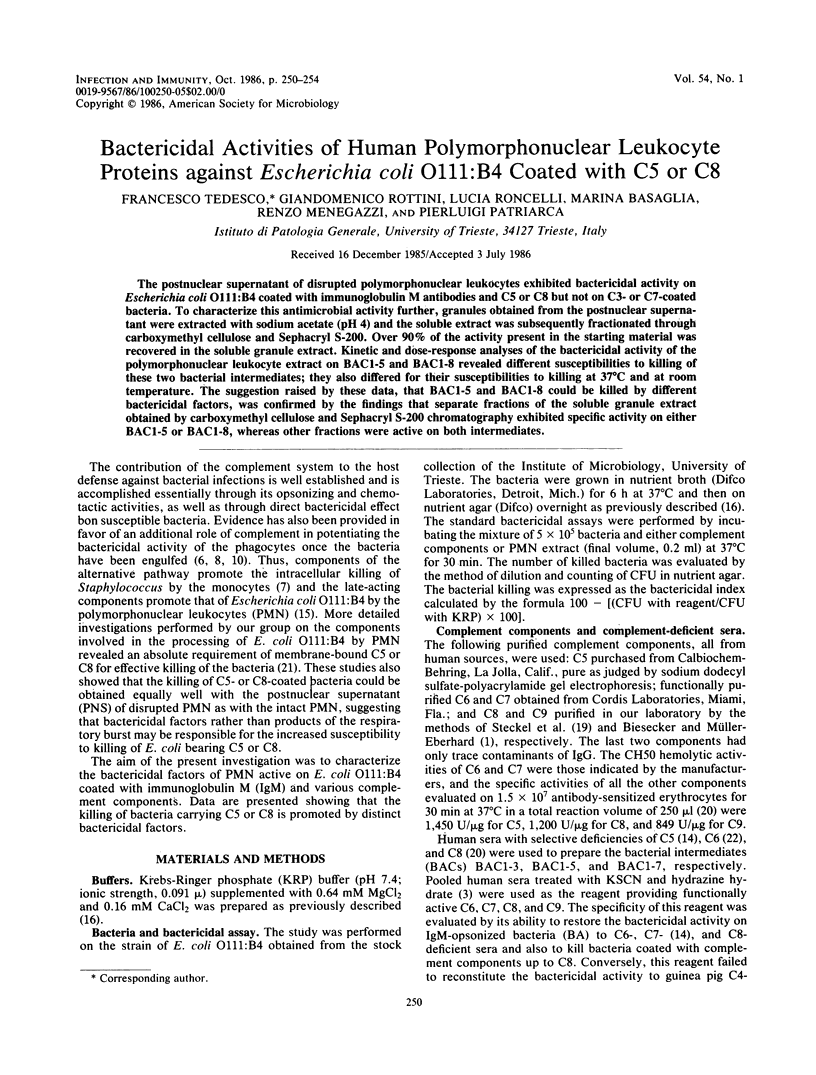
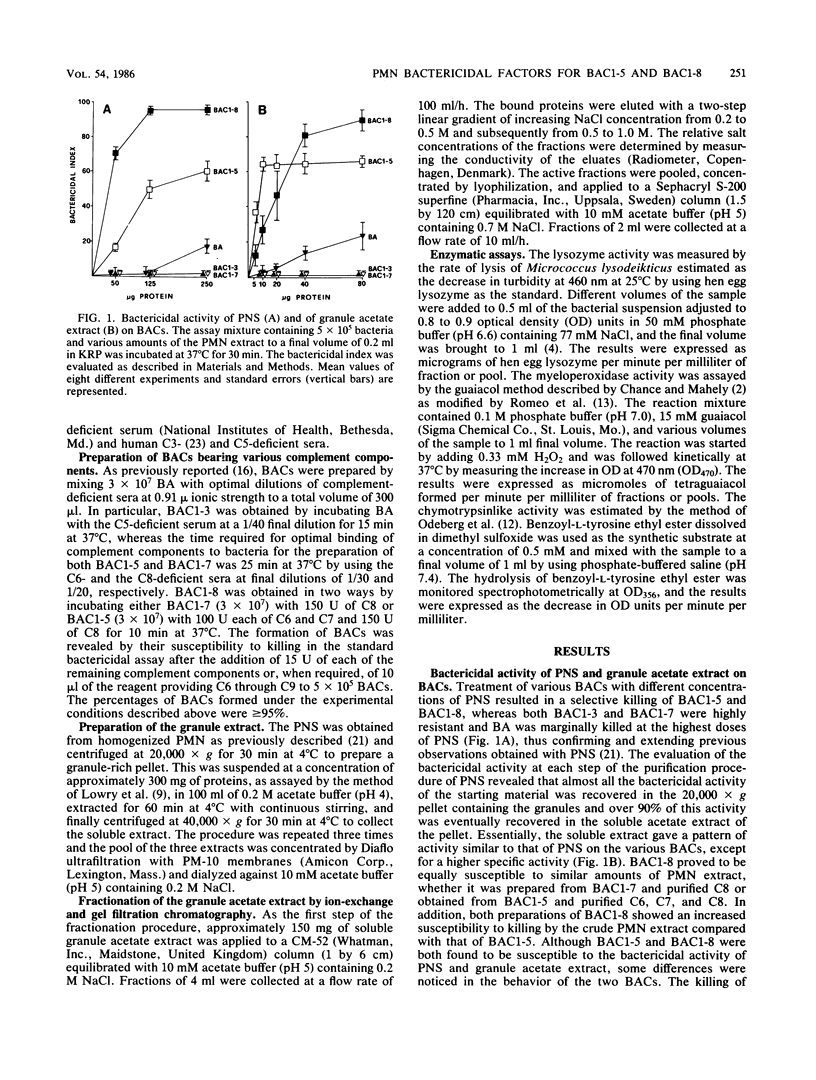
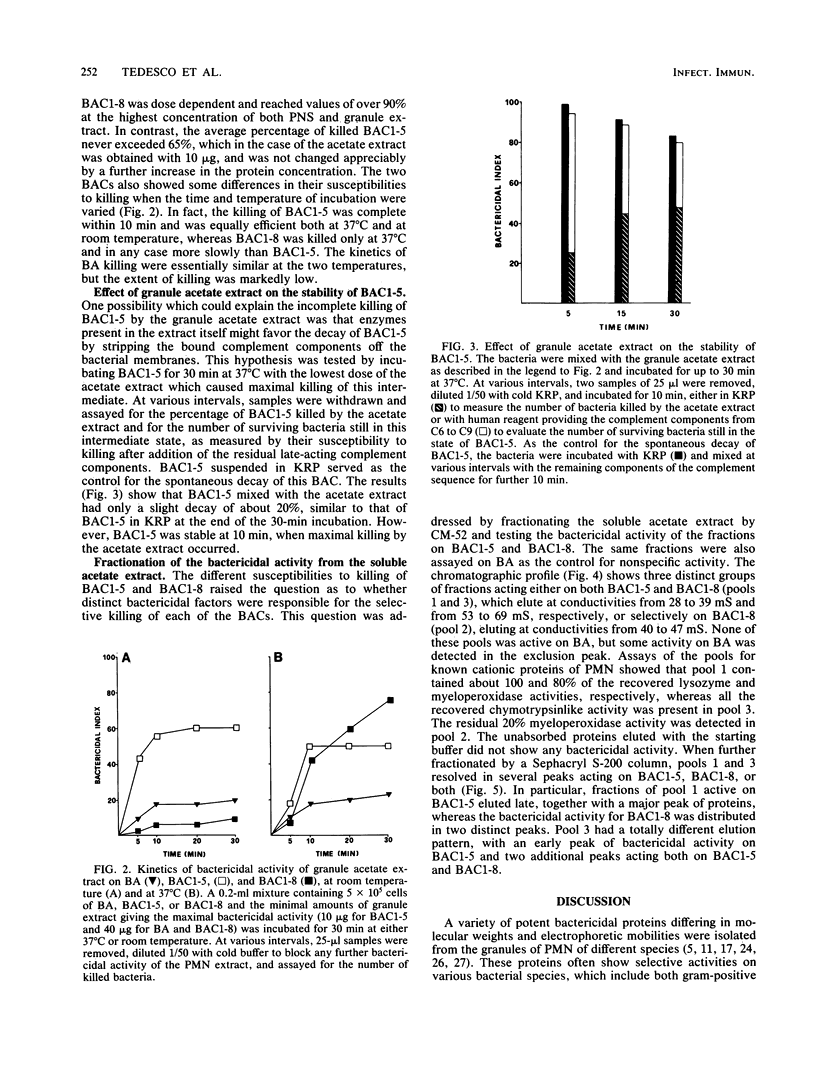
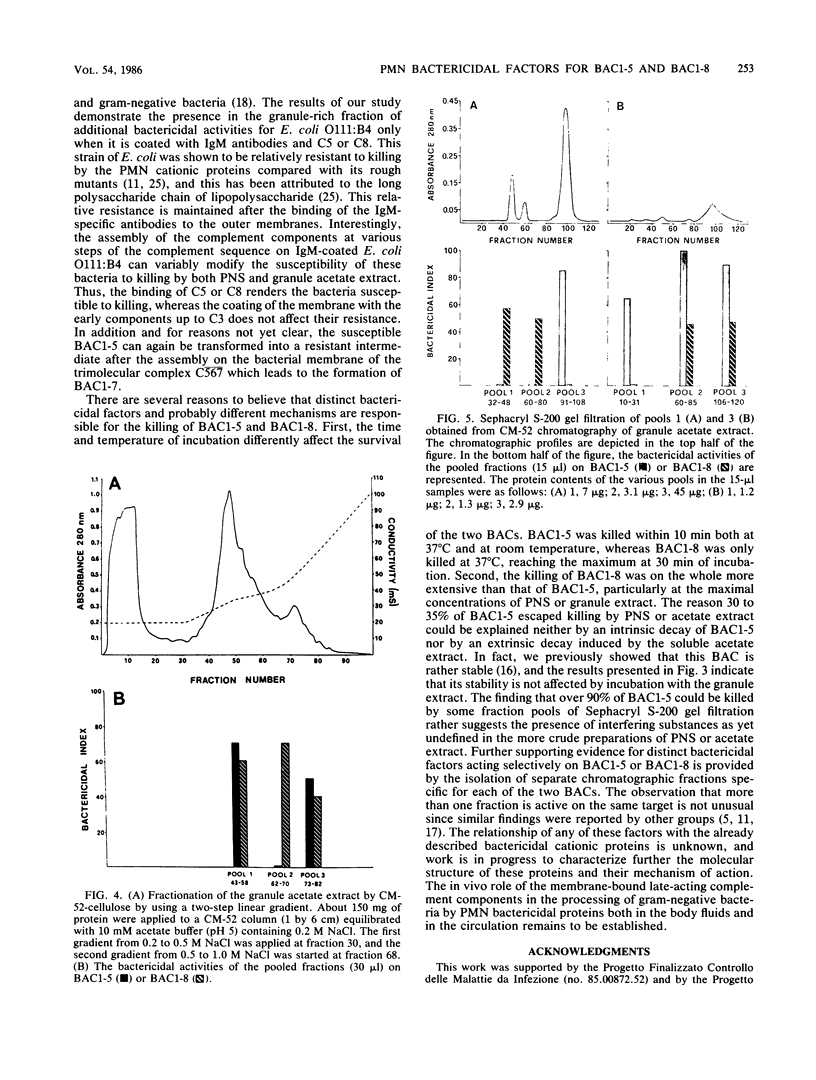
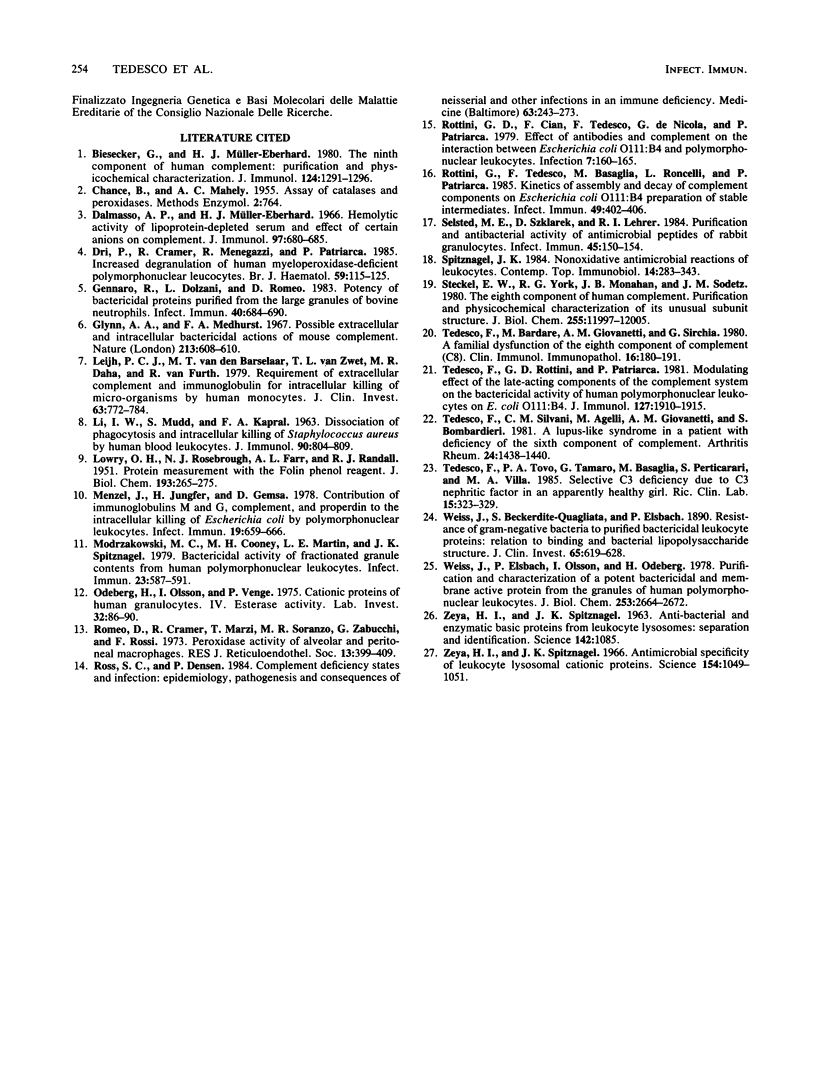
Images in this article
Selected References
These references are in PubMed. This may not be the complete list of references from this article.
- Biesecker G., Müller-Eberhard H. J. The ninth component of human complement: purification and physicochemical characterization. J Immunol. 1980 Mar;124(3):1291–1296. [PubMed] [Google Scholar]
- Dalmasso A. P., Müller-Eberhard H. J. Hemolytic activity of lipoprotein-depleted serum and the effect of certain anions on complement. J Immunol. 1966 Nov;97(5):680–685. [PubMed] [Google Scholar]
- Dri P., Cramer R., Menegazzi R., Patriarca P. Increased degranulation of human myeloperoxidase-deficient polymorphonuclear leucocytes. Br J Haematol. 1985 Jan;59(1):115–125. doi: 10.1111/j.1365-2141.1985.tb02971.x. [DOI] [PubMed] [Google Scholar]
- Gennaro R., Dolzani L., Romeo D. Potency of bactericidal proteins purified from the large granules of bovine neutrophils. Infect Immun. 1983 May;40(2):684–690. doi: 10.1128/iai.40.2.684-690.1983. [DOI] [PMC free article] [PubMed] [Google Scholar]
- Glynn A. A., Medhurst F. A. Possible extracellular and intracellular bactericidal actions of mouse complement. Nature. 1967 Feb 11;213(5076):608–610. doi: 10.1038/213608a0. [DOI] [PubMed] [Google Scholar]
- LI I. W., MUDD S., KAPRAL F. A. DISSOCIATION OF PHAGOCYTOSIS AND INTRACELLULAR KILLING OF STAPHYLOCOCCUS AUREUS BY HUMAN BLOOD LEUKOCYTES. J Immunol. 1963 May;90:804–809. [PubMed] [Google Scholar]
- LOWRY O. H., ROSEBROUGH N. J., FARR A. L., RANDALL R. J. Protein measurement with the Folin phenol reagent. J Biol Chem. 1951 Nov;193(1):265–275. [PubMed] [Google Scholar]
- Leijh P. C., van den Barselaar M. T., van Zwet T. L., Daha M. R., van Furth R. Requirement of extracellular complement and immunoglobulin for intracellular killing of micro-organisms by human monocytes. J Clin Invest. 1979 Apr;63(4):772–784. doi: 10.1172/JCI109362. [DOI] [PMC free article] [PubMed] [Google Scholar]
- Menzel J., Jungfer H., Gemsa D. Contribution of immunoglobulins M and G, complement, and properdin to the intracellular killing of Escherichia coli by polymorphonuclear leukocytes. Infect Immun. 1978 Feb;19(2):659–666. doi: 10.1128/iai.19.2.659-666.1978. [DOI] [PMC free article] [PubMed] [Google Scholar]
- Modrzakowski M. C., Cooney M. H., Martin L. E., Spitznagel J. K. Bactericidal activity of fractionated granule contents from human polymorphonuclear leukocytes. Infect Immun. 1979 Mar;23(3):587–591. doi: 10.1128/iai.23.3.587-591.1979. [DOI] [PMC free article] [PubMed] [Google Scholar]
- Odeberg H., Olsson I., Venge P. Cationic proteins of human granulocytes. IV. Esterase activity. Lab Invest. 1975 Jan;32(1):86–90. [PubMed] [Google Scholar]
- Romeo D., Cramer R., Marzi T., Soranzo M. R., Zabucchi G., Rossi F. Peroxidase activity of alveolar and peritoneal macrophages. J Reticuloendothel Soc. 1973 May;13(5):399–409. [PubMed] [Google Scholar]
- Ross S. C., Densen P. Complement deficiency states and infection: epidemiology, pathogenesis and consequences of neisserial and other infections in an immune deficiency. Medicine (Baltimore) 1984 Sep;63(5):243–273. [PubMed] [Google Scholar]
- Rottini G. D., Cian F., Tedesco F., de Nicola G., Patriarca P. Effect of antibodies and complement on the interaction between Escherichia coli 0111:B4 and polymorphonuclear leukocytes. Infection. 1979;7(4):160–165. doi: 10.1007/BF01640933. [DOI] [PubMed] [Google Scholar]
- Rottini G., Tedesco F., Basaglia M., Roncelli L., Patriarca P. Kinetics of assembly and decay of complement components on Escherichia coli O111:B4 preparation of stable intermediates. Infect Immun. 1985 Aug;49(2):402–406. doi: 10.1128/iai.49.2.402-406.1985. [DOI] [PMC free article] [PubMed] [Google Scholar]
- Selsted M. E., Szklarek D., Lehrer R. I. Purification and antibacterial activity of antimicrobial peptides of rabbit granulocytes. Infect Immun. 1984 Jul;45(1):150–154. doi: 10.1128/iai.45.1.150-154.1984. [DOI] [PMC free article] [PubMed] [Google Scholar]
- Spitznagel J. K. Nonoxidative antimicrobial reactions of leukocytes. Contemp Top Immunobiol. 1984;14:283–343. doi: 10.1007/978-1-4757-4862-8_10. [DOI] [PubMed] [Google Scholar]
- Steckel E. W., York R. G., Monahan J. B., Sodetz J. M. The eighth component of human complement. Purification and physicochemical characterization of its unusual subunit structure. J Biol Chem. 1980 Dec 25;255(24):11997–12005. [PubMed] [Google Scholar]
- Tedesco F., Bardare M., Giovanetti A. M., Sirchia G. A familial dysfunction of the eight component of complement (C8). Clin Immunol Immunopathol. 1980 Jun;16(2):180–191. doi: 10.1016/0090-1229(80)90202-0. [DOI] [PubMed] [Google Scholar]
- Tedesco F., Rottini G., Patriarca P. Moculating effect of the late-acting components of the complement system on the bactericidal activity of human polymorphonuclear leukocytes on E. coli 0111:B4. J Immunol. 1981 Nov;127(5):1910–1915. [PubMed] [Google Scholar]
- Tedesco F., Silvani C. M., Agelli M., Giovanetti A. M., Bombardieri S. A lupus-like syndrome in a patient with deficiency of the sixth component of complement. Arthritis Rheum. 1981 Nov;24(11):1438–1440. doi: 10.1002/art.1780241119. [DOI] [PubMed] [Google Scholar]
- Tedesco F., Tovo P. A., Tamaro G., Basaglia M., Perticarari S., Villa M. A. Selective C3 deficiency due to C3 nephritic factor in an apparently healthy girl. Ric Clin Lab. 1985 Oct-Dec;15(4):323–329. doi: 10.1007/BF03029146. [DOI] [PubMed] [Google Scholar]
- Weiss J., Beckerdite-Quagliata S., Elsbach P. Resistance of gram-negative bacteria to purified bactericidal leukocyte proteins: relation to binding and bacterial lipopolysaccharide structure. J Clin Invest. 1980 Mar;65(3):619–628. doi: 10.1172/JCI109707. [DOI] [PMC free article] [PubMed] [Google Scholar]
- Weiss J., Elsbach P., Olsson I., Odeberg H. Purification and characterization of a potent bactericidal and membrane active protein from the granules of human polymorphonuclear leukocytes. J Biol Chem. 1978 Apr 25;253(8):2664–2672. [PubMed] [Google Scholar]
- ZEYA H. I., SPITZNAGEL J. K. ANTIBACTERIAL AND ENZYMIC BASIC PROTEINS FROM LEUKOCYTE LYSOSOMES: SEPARATION AND IDENTIFICATION. Science. 1963 Nov 22;142(3595):1085–1087. doi: 10.1126/science.142.3595.1085. [DOI] [PubMed] [Google Scholar]
- Zeya H. I., Spitznagel J. K. Antimicrobial specificity of leukocyte lysosomal cationic proteins. Science. 1966 Nov 25;154(3752):1049–1051. doi: 10.1126/science.154.3752.1049. [DOI] [PubMed] [Google Scholar]



